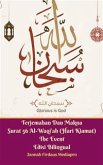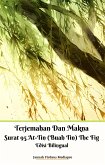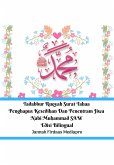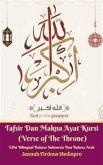Terjemahan Dan Makna Surat 19 Maryam (Siti Maryam) Virgin Mary Edisi Bilingual Dalam Bahasa Indonesia & Bahasa Inggris Versi Standar.
Surah Maryam (bahasa Arab: مريم, Maryam, "Maryam") adalah surah ke-19 dalam al-Qur'an. Surah ini terdiri atas 98 ayat dan termasuk golongan surah-surah Makkiyah karena hampir seluruh ayatnya diturunkan sebelum Nabi Muhammad SAW hijrah ke Madinah, bahkan sebelum sahabat-sahabat dia hijrah ke negeri Habsyi. Menurut riwayat Ibnu Mas'ud, Ja'far bin Abi Thalib membacakan permulaan surah Maryam ini kepada raja Najasyi dan pengikut-pengikutnya di waktu ia ikut hijrah bersama-sama sahabat-sahabat yang lain ke negeri Habsyi.
Surah ini dinamai Maryam, karena surat ini mengandung kisah Maryam (atau Maria dalam agama Kristen), ibu dari Nabi Isa AS. Surah ini menceritakan kelahiran yang ajaib, di mana Ia melahirkan Isa AS sedang ia sebelumnya belum pernah digauli oleh seorang laki-laki. Kelahiran Isa AS tanpa ayah, merupakan suatu bukti kekuasaan Allah SWT. Pengutaraan kisah Maryam sebagai kejadian yang luar biasa dan ajaib dalam surah ini, diawali dengan kisah kejadian ajaib lainnya, yaitu dikabulkannya doa nabi Zakaria AS oleh Allah SWT, di mana ia ingin dianugerahi seorang putra sebagai pewaris dan penerus cita-cita dan kepercayaannya.
Maryam (Arabic: مريم, "Mary") is the 19th chapter (sūrah) of the Qur'an and is a "Meccan sūrah" with 98 verses (āyāt). It is named after Mary, the mother of Jesus (Isa), who appears in verses 16–34. Regarding the timing and contextual background of the supposed revelation (asbāb al-nuzūl), it is an earlier "Meccan Surah", which means it is believed to have been revealed in Mecca, instead of later in Medina. Theodor Nöldeke's chronology identifies this Surah as the 58th Surah delivered, while the traditional Egyptian chronology places it as the 44th.
The sura opens with the Bismillah and five Arabic letters: Kaf Ha Ya 'Ayn Sad. The remaining 97 ayat can be divided into three primary sections. The first section, verses 2–40, consists of the narrative of the prophet Zachariah and the birth of his son John, the story of Mary and the birth of her son Jesus, and a commentary on Jesus' true identity which rejects the Christian claim that he is God's son. The second section, verses 41–65, tells of Abraham's departure from his family's idolatrous ways and then refers to many other prophets. The text discusses the various responses of those who heard their prophecy and the fates those hearers met; throughout these descriptions, the oneness of God is emphasized. The third section, verses 66–98, confirms the reality of resurrection and offers depictions of the Day of Judgment alongside depictions of this life.
Surah Maryam (bahasa Arab: مريم, Maryam, "Maryam") adalah surah ke-19 dalam al-Qur'an. Surah ini terdiri atas 98 ayat dan termasuk golongan surah-surah Makkiyah karena hampir seluruh ayatnya diturunkan sebelum Nabi Muhammad SAW hijrah ke Madinah, bahkan sebelum sahabat-sahabat dia hijrah ke negeri Habsyi. Menurut riwayat Ibnu Mas'ud, Ja'far bin Abi Thalib membacakan permulaan surah Maryam ini kepada raja Najasyi dan pengikut-pengikutnya di waktu ia ikut hijrah bersama-sama sahabat-sahabat yang lain ke negeri Habsyi.
Surah ini dinamai Maryam, karena surat ini mengandung kisah Maryam (atau Maria dalam agama Kristen), ibu dari Nabi Isa AS. Surah ini menceritakan kelahiran yang ajaib, di mana Ia melahirkan Isa AS sedang ia sebelumnya belum pernah digauli oleh seorang laki-laki. Kelahiran Isa AS tanpa ayah, merupakan suatu bukti kekuasaan Allah SWT. Pengutaraan kisah Maryam sebagai kejadian yang luar biasa dan ajaib dalam surah ini, diawali dengan kisah kejadian ajaib lainnya, yaitu dikabulkannya doa nabi Zakaria AS oleh Allah SWT, di mana ia ingin dianugerahi seorang putra sebagai pewaris dan penerus cita-cita dan kepercayaannya.
Maryam (Arabic: مريم, "Mary") is the 19th chapter (sūrah) of the Qur'an and is a "Meccan sūrah" with 98 verses (āyāt). It is named after Mary, the mother of Jesus (Isa), who appears in verses 16–34. Regarding the timing and contextual background of the supposed revelation (asbāb al-nuzūl), it is an earlier "Meccan Surah", which means it is believed to have been revealed in Mecca, instead of later in Medina. Theodor Nöldeke's chronology identifies this Surah as the 58th Surah delivered, while the traditional Egyptian chronology places it as the 44th.
The sura opens with the Bismillah and five Arabic letters: Kaf Ha Ya 'Ayn Sad. The remaining 97 ayat can be divided into three primary sections. The first section, verses 2–40, consists of the narrative of the prophet Zachariah and the birth of his son John, the story of Mary and the birth of her son Jesus, and a commentary on Jesus' true identity which rejects the Christian claim that he is God's son. The second section, verses 41–65, tells of Abraham's departure from his family's idolatrous ways and then refers to many other prophets. The text discusses the various responses of those who heard their prophecy and the fates those hearers met; throughout these descriptions, the oneness of God is emphasized. The third section, verses 66–98, confirms the reality of resurrection and offers depictions of the Day of Judgment alongside depictions of this life.









